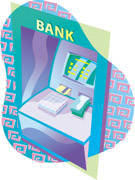Automatic teller machines have been popping up all over the U.S. faster than you can say “Starbucks.” Eschewing long lines at bank branches, consumers have incorporated a stop at the ATM into their daily routines. But these ubiquitous money access centers with their accompanying surcharges aren’t as much of a cash cow for financial institutions as many consumers think. Indeed, they are more often a necessary service and branding opportunity in an ever more competitive marketplace.
To help increase the revenues generated by their ATMs, some banks are moving to offer services beyond mere cash withdrawals. Already many ATMs allow consumers to buy stamps, print mini-statements, and pay bills. Some offer coupons, slide-show advertising, and check cashing, and a few even offer phone cards, maps, and travel/event ticketing – all for a small fee, of course. In the U.K., for instance, Abbey National Bank customers are able to top up their mobile phone minutes through ATMs. In the U.S., Bank of America has partnered with CNN to promote programs on its cash machines.
In order to support all this extra functionality, many banks are migrating to Internet protocol-enabled machines, which allow more centralized programming and advanced feature deployment. How consumers will react to all the bells and whistles, however, is still an open question.
Declining balances
The advent of surcharging in 1996 saw a rapid increase in the number of ATMs, as banks sought to take advantage of the new revenue opportunity. But this growth essentially eroded any large opportunity for profits. Due in part to the rapid proliferation of machines, the number of transactions at each ATM has been going down. According to ATM&Debit News, monthly transactions per ATM declined from 6,876 in 1992, when there were 87,330 terminals, to 3,308 in 2002, with 352,000 terminals.
The 2002 ATM Deployer Study by Pulse and Dove Consulting reports that on average, the monthly operation cost of an ATM is between $1,000 and $2,000, while monthly revenues are only slightly – if at all – higher. In addition, as debit cards and cashless transactions become more popular, demand for cash withdrawals is expected to decrease.
ATM operation costs are largely fixed regardless of the number of transactions – the purchase price of the machine, its maintenance, replenishment of currency, and the network connection. (The three largest electronic funds transfer networks in the U.S. are Star, NYCE, and Pulse.)
Wharton graduate Katarina Stefanovic, vice president in the Business Transformation Group at JPMorgan Chase, notes that replenishment can be a significant cost. “If the ATM is located at a branch, banks have the option of having staff replenish the machines with cash. Remote location replenishment, however, is usually outsourced. Especially in the case of front-loading ATMs – which cannot be serviced from a safe back room – the cost has to take into account security, cash couriers with armored cars, etc.” Adding features can add costs, too. “If a bank offers other goods, for example, through existing machines – and those tickets or subway cards or stamps fill some of the cash cassettes in the machine – then the cash will have to be replaced more often,” notes Stefanovic.
Financial institutions typically administer two types of ATMs – on-premises and off. While a bank’s on-premises ATM is largely immune to competition, its off-premises ATMs represent the greatest opportunity for fee revenue, since other banks’ cardholders are charged for their use.
Initially conceived as a customer-service enhancement, ATMs began to be viewed as a potential profit center with the introduction of surcharges. As transaction volumes stagnate, however, ATMs are again being viewed as customer-service channels.
Reducing the need for tellers and other branch personnel is usually a big plus for the financial institutions, says Wharton marketing professor Barbara Kahn. “People are most expensive to banks. So as far as banks can eliminate that human aspect, it’s a good thing for them.” Stefanovic agrees, explaining that most financial institutions see ATMs as a service channel; some see them as a sales channel; and others see them as a branding opportunity.
The decision to add new ATMs is based on several factors, says Stefanovic. “A bank can study usage volumes on its ATMs. Where are the bank’s customers withdrawing money at other banks’ machines? Since the bank incurs a cost when their customers use other financial institutions’ ATMs, it might make sense to add an ATM in that location. Banks may also decide to expand into certain markets based on where their customers live or work.”
Higher technology
Traditionally, one obstacle to the delivery of advanced services is the proprietary software technology of most ATMs, which makes reprogramming prohibitively time-consuming and expensive. Newer machines based on common Internet standards, however, enable banks to deploy functionality from a centralized system and deliver similar services across several channels (such as online, over the phone, and through ATMs).
These new machines are not connected to the world wide web. Rather, they simply allow communication and programming using standard Internet protocols and scripting. Many banks plan to upgrade to these web-enabled systems during the next two years. One of the primary goals is to link banks’ customer relationship management (CRM) systems to ATMs so as to use them to both customize the user experience and cross-sell or up-sell other products and services relevant to the user.
“At the very least, web-enabled ATMs allow customers to choose their fast cash and language preferences, change their PIN (personal identification number), and so on, thus making the experience more efficient. Instead of the ATM being a silo, it can be integrated with the other service channels that a bank offers,” says Stefanovic.
In the U.S., approximately 32% of financial institutions offer customers mini-statements at ATMs, and 23% offer postage stamps. 7-11 retail stores are experimenting with Vcom kiosk ATMs, which offer money orders and transfers (handled by Western Union), and check cashing (handled by Certegy Check Services).
While consumers often indicate interest in new services at ATMs, they have not necessarily embraced them (possibly because there is a familiarity/learning curve) when these are actually deployed. The industry is therefore caught in a vicious circle – banks do not offer the services since customers ignore them, but customers do not use them because they are not offered.
Consumer psyche
Kahn believes that as long as customers have the option to bypass the extra functionality, the new services might work well. “The advantage of the ATM has always been speed and convenience. So if all these new services cause lines to be longer, then that’s not good. They’ll have to separate the lines so that people who just want cash are in one line, and other people can do other things,” notes Kahn.
Eric Clemons, professor of operations and information management at Wharton, is skeptical of the benefits of targeting advertising and services to customers through ATMs. “It’s probably not the right channel and certainly not the right time. If I am running to the airport or illegally parked and the ATM starts trying to cross-sell me, I will be enraged,” he notes.
Stefanovic says that many banks, especially the larger ones, should be wary of bombarding consumers with irrelevant functionality or advertising. “One way banks are beginning to handle this issue is to turn off extra features during peak usage hours. Even advertising can be programmed to take up less time, require less interaction from the customer, etc. to speed up lines,” she says.
Targeted advertising, note experts, needs to be particularly well handled. “If the advertising or offering of services using demographic data is transparent, consumers may react positively. What I think isn’t so useful is an overt attempt to advertise,” Kahn says. “If the consumer sees it as useful information, fine. Perhaps the ATM will suggest things that are helpful – for instance, saying ‘We notice your balance is low, can we help with a loan?’ If it’s solving a customer’s problem, that’s good. However, as is usually the case, the step before that isn’t always so customized. Like random telemarketing, it would be perceived as annoying.”
Customers have not reacted well to bank tellers’ attempts at marketing services, notes Clemons. “Cross-selling at the platform (the teller station in retail branches) has been a terrible failure. Customers hate it. They want to come in, transact, and leave as fast as possible.”
It may take time for customers to become accustomed to new features, says Kahn. “The only way it would work is if people have an attitude change toward the ATM and start relying on it for these other services. But such an attitude change will only occur if the ATM is perceived as a more efficient way to conduct transactions. If there’s just a lot of distracting junk, they’re not going to see it as being attractive. It shouldn’t waste the user’s time. If companies start using sledgehammer tactics, as is often the case, that’s not going to happen.”
Kahn also points out that perception is a key factor when it comes to surcharges. “I tend not to think in terms of price. The right way is to think about it is in terms of value – the relationship of quality to price. If banks clearly offer something of utility to consumers, then they should be willing to pay for it. If not, it’s not truly valuable. If I don’t have to go to the post office, the convenience of getting stamps at an ATM is valuable and I wouldn’t mind paying for that. If it’s perceived as paying extra for the same thing, it’s not good. There are lots of ways to price it. Perhaps it could be a reward – ’If you take out a big loan, you can buy stamps at our ATM at no charge,’ etc.”
Will consumers want to do these extra errands at an ATM when they can also do them elsewhere? As long as society requires tangible items as proof of purchase, yes, says Kahn. “The advantage of the ATM is the ability for physical property to be passed in and out in real time. At an ATM, you can pick up paper tickets, stamps, etc. You can’t do this easily right now online at your computer.”



